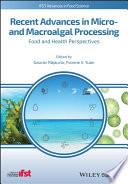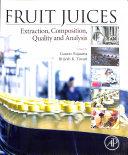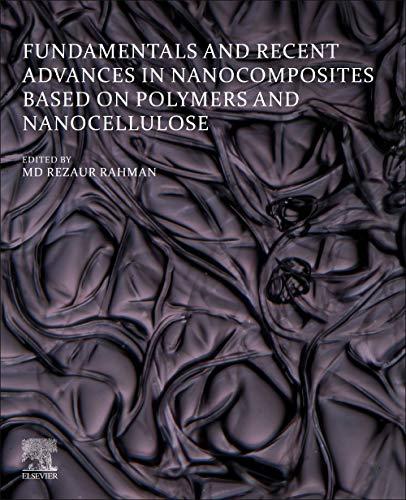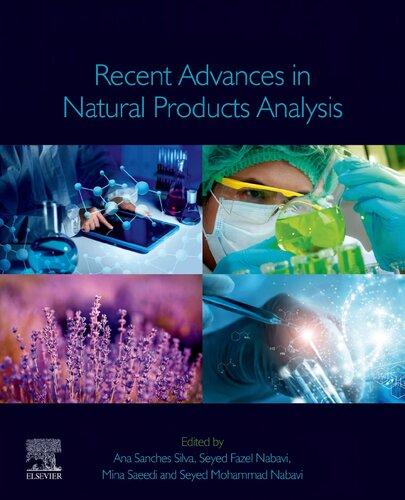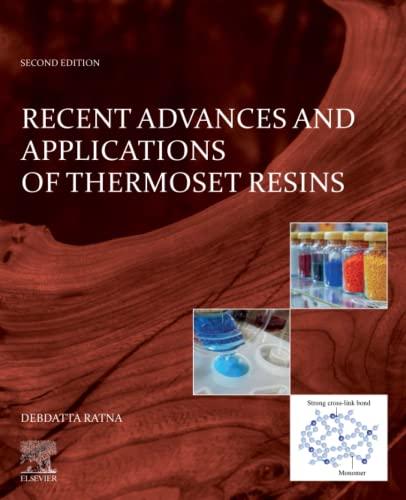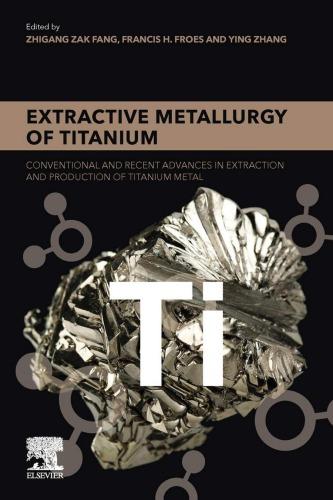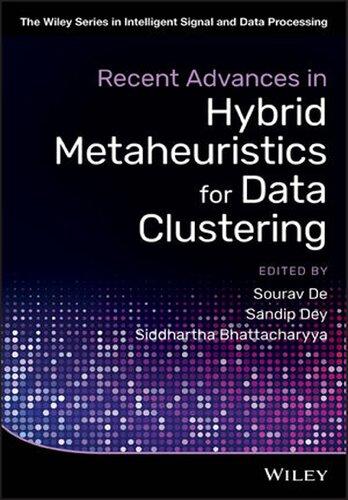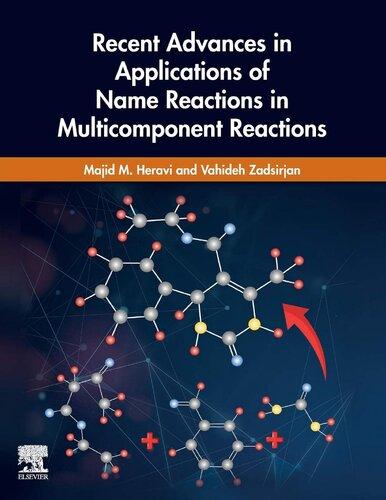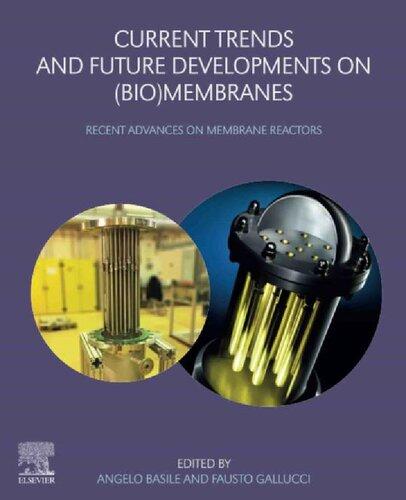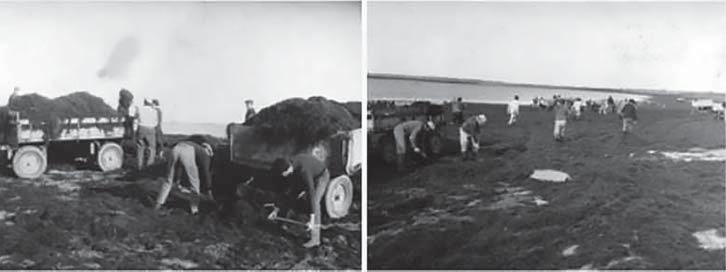Recent Advances in Micro- and Macroalgal Processing Gaurav Rajauria Visit to download the full and correct content document: https://ebookmass.com/product/recent-advances-in-micro-and-macroalgal-processing -gaurav-rajauria/
More products digital (pdf, epub, mobi) instant download maybe you interests ...
Fruit Juices: Extraction, Composition, Quality and Analysis Gaurav Rajauria
https://ebookmass.com/product/fruit-juices-extractioncomposition-quality-and-analysis-gaurav-rajauria/
Fundamentals and Recent Advances
in Nanocomposites Based on Polymers and Nanocellulose Md Rezaur Rahman
https://ebookmass.com/product/fundamentals-and-recent-advancesin-nanocomposites-based-on-polymers-and-nanocellulose-md-rezaurrahman/
Recent Advances in Natural Products Analysis 1st Edition Seyed Mohammad Nabavi (Editor)
https://ebookmass.com/product/recent-advances-in-naturalproducts-analysis-1st-edition-seyed-mohammad-nabavi-editor/
Recent Advances and Applications of Thermoset Resins 2nd Edition Debdatta Ratna
https://ebookmass.com/product/recent-advances-and-applicationsof-thermoset-resins-2nd-edition-debdatta-ratna/
Extractive Metallurgy of Titanium: Conventional and Recent Advances in Extraction and Production of Titanium Metal Fang
https://ebookmass.com/product/extractive-metallurgy-of-titaniumconventional-and-recent-advances-in-extraction-and-production-oftitanium-metal-fang/
Recent Advances in Hybrid Metaheuristics for Data Clustering 1. Edition Sourav De (Editor)
https://ebookmass.com/product/recent-advances-in-hybridmetaheuristics-for-data-clustering-1-edition-sourav-de-editor/
Recent Advances in Applications of Name Reactions in Multicomponent Reactions 1st Edition Majid
M. Heravi https://ebookmass.com/product/recent-advances-in-applications-ofname-reactions-in-multicomponent-reactions-1st-edition-majid-mheravi/
Handbook of Thermal Analysis and Calorimetry: Recent Advances, Techniques and Applications 2nd Edition Sergey Vyazovkin
https://ebookmass.com/product/handbook-of-thermal-analysis-andcalorimetry-recent-advances-techniques-and-applications-2ndedition-sergey-vyazovkin/
Current Trends and Future Developments on (Bio-) Membranes: Recent Advances on Membrane Reactors Angelo Basile
https://ebookmass.com/product/current-trends-and-futuredevelopments-on-bio-membranes-recent-advances-on-membranereactors-angelo-basile/
RecentAdvancesinMicro-and MacroalgalProcessing RecentAdvancesin Micro-andMacroalgal Processing FoodandHealthPerspectives Editedby
GauravRajauria UniversityCollegeDublin,Ireland
YvonneV.Yuan RyersonUniversity,Canada
Thiseditionfirstpublished2021
©2021JohnWiley&Sons,Ltd.
Allrightsreserved.Nopartofthispublicationmaybereproduced,storedinaretrievalsystem,ortransmitted,in anyformorbyanymeans,electronic,mechanical,photocopying,recordingorotherwise,exceptaspermittedby law.Adviceonhowtoobtainpermissiontoreusematerialfromthistitleisavailableat http://www.wiley.com/go/ permissions
TherightofGauravRajauriaandYvonneV.Yuantobeidentifiedastheauthorsoftheeditorialmaterialinthis workhasbeenassertedinaccordancewithlaw.
RegisteredOffice(s)
JohnWiley&Sons,Inc.,111RiverStreet,Hoboken,NJ07030,USA
JohnWiley&SonsLtd,TheAtrium,SouthernGate,Chichester,WestSussex,PO198SQ,UK
EditorialOffice
TheAtrium,SouthernGate,Chichester,WestSussex,PO198SQ,UK
Fordetailsofourglobaleditorialoffices,customerservices,andmoreinformationaboutWileyproductsvisitusat www.wiley.com
Wileyalsopublishesitsbooksinavarietyofelectronicformatsandbyprint-on-demand.Somecontentthat appearsinstandardprintversionsofthisbookmaynotbeavailableinotherformats.
LimitofLiability/DisclaimerofWarranty
Whilethepublisherandauthorshaveusedtheirbesteffortsinpreparingthiswork,theymakenorepresentations orwarrantieswithrespecttotheaccuracyorcompletenessofthecontentsofthisworkandspecificallydisclaimall warranties,includingwithoutlimitationanyimpliedwarrantiesofmerchantabilityorfitnessforaparticularpurpose. Nowarrantymaybecreatedorextendedbysalesrepresentatives,writtensalesmaterialsorpromotionalstatements forthiswork.Thefactthatanorganization,website,orproductisreferredtointhisworkasacitationand/or potentialsourceoffurtherinformationdoesnotmeanthatthepublisherandauthorsendorsetheinformationor servicestheorganization,website,orproductmayprovideorrecommendationsitmaymake.Thisworkissoldwith theunderstandingthatthepublisherisnotengagedinrenderingprofessionalservices.Theadviceandstrategies containedhereinmaynotbesuitableforyoursituation.Youshouldconsultwithaspecialistwhereappropriate. Further,readersshouldbeawarethatwebsiteslistedinthisworkmayhavechangedordisappearedbetweenwhen thisworkwaswrittenandwhenitisread.Neitherthepublishernorauthorsshallbeliableforanylossofprofit oranyothercommercialdamages,includingbutnotlimitedtospecial,incidental,consequential,orotherdamages.
LibraryofCongressCataloging-in-PublicationData
Names:Rajauria,Gaurav,editor.|Yuan,YvonneV.,editor.
Title:Recentadvancesinmicroandmacroalgalprocessing:foodandhealth perspectives/editedbyGauravRajauria,UniversityCollegeDublin, Ireland,YvonneV.Yuan,RyersonUniversity,Canada.
Description:Firstedition.|Hoboken,NJ,USA:Wiley-Blackwell,2021.| Series:IFSTadvancesinfoodsciencebookseries|Includes bibliographicalreferencesandindex.
Identifiers:LCCN2020048355(print)|LCCN2020048356(ebook)|ISBN 9781119542582(hardback)|ISBN9781119542629(adobepdf)|ISBN 9781119542612(epub)
Subjects:LCSH:Algae–Biotechnology.|Algaeasfood.| Microalgae–Industrialapplications.
Classification:LCCTP248.27.A46R432021(print)|LCCTP248.27.A46 (ebook)|DDC660.6–dc23
LCrecordavailableathttps://lccn.loc.gov/2020048355
LCebookrecordavailableathttps://lccn.loc.gov/2020048356
CoverDesign:Wiley
CoverImages:Lab&ScienceVectorIconSet,©fleaz/iStockphoto,Beautifultropicalseascape.Skyandsea© Efired/Shutterstock,farmingicons©bioraven/Shutterstock,Coalindustryiconsblacksetwithtraintruckfactory isolatedvectorillustration©Macrovector/Shutterstock,GreenSeaweed©divedog/Shutterstock,Single-cell algaewithlipiddroplets.Biofuelproduction.Illustrationofmicroalgaeunderthemicroscope,isolatedonwhite© Perception7/Shutterstock
Setin9.5/11.5pt,TimesLTStdbySPiGlobal,Chennai,India.
10987654321
Acknowledgments Inourpreparationandeditingofthisbookwehavehadtheassistanceofnumerous colleaguesandsupportfromfriendsandfamilyforwhichwearebothgreatlyappreciative.
Whenwefirststartedthisproject,weneverdreamedthattheglobalcommunity wouldbechallengedbytheCOVID-19pandemic,whichisnowarealityaswefinalize thisvolumeforpublication.Weareextremelygratefultoourcontributorsfromacross theglobewhohavebeendiligentlylaboringfromtheirhomesduringthesedifficult timesandcontinuedtosuccessfullycompletethechapterswithrevisionsprovidedby theeditors.
Inaddition,wearedeeplyhumbledandwanttothankourpassionatemanaging editor,projecteditor,copyeditor,andourfabulouscommissioningteam,production team,administrative,IT,andsupportstaffatWiley.
Finally,wewouldliketodedicatethisworkwithahugethankyoutothearrayof frontlineworkersacrosstheworldwhoarecourageouslyandvaliantlyworkingevery daytosupportusallinthefightagainstthedeadlyCOVID-19virus.Thereareno wordsthatcanadequatelyexpressourgratitudeforallthatyouaredoingduringthis difficulttime.Wewishyouandyourfamiliessafetyandhealthasyouforgeaheadto getustotheothersideofthispandemic.Yourcontributionsareappreciated,andwe thankyouinourprayers,hearts,andmindseveryday.WESALUTEYOU!
Acknowledgmentsv AbouttheIFSTAdvancesinFoodScienceBookSeriesxvii ListofContributorsxix Prefacexxiii
SectionICOMPOSITIONANDEXTRACTIONTECHNOLOGIESFOR ALGALBIOACTIVES
1Algae:AFunctionalFoodwithaRichHistoryandFutureSuperfood3 GauravRajauria,andYvonneV.Yuan
1.1Introduction3
1.2HistoryofMacro-andMicroalgaeConsumption4
1.3EconomicRelevanceofMacro-andMicroalgae6
1.4BookObjectives7
1.5BookStructure7 References11
2InfluenceofSeasonalVariationonChemicalCompositionandNutritional ProfilesofMacro-andMicroalgae14 K.SureshKumar,SushmaKumari,KamleshwarSingh,andPratibhaKushwaha 2.1Introduction14
2.2InfluenceofSeasonalVariationonBiochemicalCompositionofMicro-and Macroalgae22 2.3Pigments24 2.4Carbohydrates/Polysaccharides31 2.5FiberContent36 2.6Proteins38
2.6.1Mycosporine-LikeAminoAcids(MAAs)46 2.6.2PhycobiliproteinsandLectins47 2.7LipidsandPUFAs48 2.8InorganicElementsandMinerals52
2.9Vitamins56 2.10PhenolicCompounds57 2.11OtherCompounds59 2.12Conclusion59 References60
3AdvancesinDryingandMillingTechnologiesforAlgae72
K.Y.Show,Y.G.Yan,andDuu-JongLee
3.1Introduction72
3.2AlgalCellDryingTechnologies74
3.2.1SolarDrying74
3.2.2OvenDrying76
3.2.3FreezeDrying77
3.2.4RotaryDrumDrying77
3.2.5IncineratorDrying78
3.2.6SprayDrying78
3.2.7HeatCirculationDrying79
3.2.8MicrowaveDrying80
3.2.9PolypropyleneNonwovenMembraneDrying80
3.2.10RefractanceWindow® Drying81
3.3AlgalCellMillingTechnologies81
3.3.1Vortex-BeadMilling81
3.3.2Shake-BeadMilling83
3.3.3High-PressureHomogenization84
3.3.4High-SpeedHomogenization86
3.3.5LiquidNitrogenGrinding86
3.4ChallengesandProspects87
3.4.1ProcessingTechnology87
3.4.2EnergyRequirement87
3.4.3ProductQuality88
3.4.4EnvironmentalImpacts88
3.4.5FutureDirections89
3.5Conclusion89 References89
4RecentAdvancesintheUseofGreenerExtractionTechnologiesforthe RecoveryofValuableBioactiveCompoundsfromAlgae96 MarcoGarcia-Vaquero,TorresSweeney,JohnO’Doherty,andGauravRajauria 4.1Introduction96
4.2GreenExtractionTechnologiesandApplications98
4.2.1PulsedElectricField(PEF)98
4.2.2SupercriticalFluidExtraction(SFE)101
4.2.3PressurizedLiquidExtraction(PLE)106
4.2.4MicrowaveAssistedExtraction(MAE)108
4.2.5UltrasoundAssistedExtraction(UAE)110
4.3CombinationTechniques112
4.4ChallengesandFuturePerspectives115 Acknowledgments116 References116
5ExtractionTechnologiesforFunctionalLipids123 CalleNiemiandFrancescoG.Gentili
5.1Introduction123
5.2ConventionalExtractionTechniquesforFunctionalLipids124
5.3ApplicationofNovelExtractionTechnologiesforFunctionalLipids127
5.3.1AlgalCellDisruptionMethods127
5.3.2NovelExtractionMethods129
5.4FutureRecommendations134 Acknowledgments134 References135
6ExtractionTechnologiesforProteinsandPeptides141 ArianeTremblayandLucieBeaulieu
6.1Introduction141
6.2ConventionalExtractionTechniquesforProteinsandPeptides144
6.2.1CellDisruptionMethods144
6.2.2ChemicalExtraction147
6.2.3EnzymaticProcesses148
6.2.4Recovery/EnrichmentTechniques149
6.2.5ProteinExtractionMethodsinProteomics150
6.3EmergingTechnologiesforProteinsandPeptides151
6.3.1MicrowaveAssistedExtraction(MAE)151
6.3.2PulsedArcTechnology151
6.3.3PressurizedLiquidExtraction(PLE)153
6.3.4Sub-andSupercriticalFluidExtraction(SFE)153
6.3.5HighHydrostaticPressure(HHP)andUltra-highPressureExtraction (UHP)154
6.4ConclusionandFutureOutlook154 References155
7ExtractionTechnologiestoRecoverDietaryPolyphenolsfromMacro-and Microalgae163 M.Shanmugam,AbiramiRamuGanesan,andGauravRajauria
7.1Introduction163
7.2ConventionalExtractionTechniquesforPolyphenols164
7.2.1Liquid-LiquidExtraction(LLE)165
7.2.2Solid-LiquidExtraction(SLE)165
7.3InnovativeExtractionTechnologiesforIsolationofPolyphenolsfromMacroalgae166
7.3.1Enzyme-AssistedExtraction(EAE)166
7.3.2MicrowaveAssistedExtraction(MAE)169
7.3.3PressurizedLiquidExtraction(PLE)170
7.3.4SubcriticalWaterExtraction(SWE)171
7.3.5SupercriticalFluidExtraction(SFE)174
7.3.6UltrasoundAssistedExtraction(UAE)176
7.4FactorsAffectingExtraction178
7.4.1pH179
7.4.2Solvents180
7.5ChallengesandFutureRecommendations180 Acknowledgments180 References181
8ExtractionTechnologiesforBioactivePolysaccharides188 RashidaQariandRajeevRavindran
8.1Introduction188
8.2PolysaccharidesinSeaweed189
8.3ConventionalTechnologiesforPolysaccharideExtraction192
8.4AdvancedTechnologiesforPolysaccharideExtraction200
8.4.1MicrowaveAssistedExtraction(MAE)200
8.4.2UltrasoundAssistedExtraction(UAE)201
8.4.3PressurizedLiquidExtraction(PLE)202
8.4.4EnzymeAssistedExtraction(EAE)203
8.5Conclusion203 References203
SectionIIBIOLOGICALPROPERTIESOFALGALDERIVED COMPOUNDS
9PotentialBiologicalActivitiesAssociatedwithAlgalDerivedCompounds211 YvonneV.Yuan
9.1Introduction211
9.2AntioxidantandAnticarcinogenicActivitiesofMacro-andMicroalgalConstituents213
9.2.1Mycosporine-likeAminoAcids(MAAs)214
9.2.2Scytonemins218
9.2.3Pterins220
9.2.4CarotenesandXanthophylls221
9.3AntiobesogenicBiologicalActivitiesofMacroalgalConstituents224
9.4AntidiabeticBiologicalActivitiesofMacroalgalConstituents224
9.5PrebioticBiologicalActivitiesofMacroalgalConstituents226
9.6ImmuneSystemBiologicalActivitiesofMacroalgalConstituents227 9.7ConclusionandFutureWork227 Acknowledgments227 References228
10AlgalPolysaccharidesandTheirBiologicalProperties231 Kit-LeongCheong,ValentinaJesumani,BilalMuhammadKhan,YangLiu,and HongDu
10.1Introduction231
10.2StructureofMarineAlgaePolysaccharides232
10.2.1Agar234
10.2.2Alginates234
10.2.3Carrageenan235
10.2.4Cellulose235
10.2.5Fucoidans236
10.2.6Laminarans237
10.2.7Mannans238
10.2.8SulfatedRhamnans239 10.2.9Ulvans239
10.2.10Xylans239
10.3IsolationandPurificationofPolysaccharidesfromAlgae240
10.3.1Isolation241
10.3.2Purification246 10.4Health-PromotingActivitiesofMAP248
10.4.1AntioxidantActivity249
10.4.2ImmunomodulatoryActivity253
10.4.3AnticancerActivity256
10.4.4AntiviralActivity257
10.4.5AntihyperlipidemicActivity260
10.4.6AnticoagulantActivity261 10.4.7AntimicrobialActivity262 10.5ConclusionandFutureTrends263 References264
11MarineAlgalDerivedPhenolicCompoundsandtheirBiologicalActivities forMedicinalandCosmeticApplications278 LeslieGager,FannyLalegerie,SolèneConnan,andValérieStiger-Pouvreau 11.1Introduction278 11.2TypesandStructuresofPhenolicCompoundsfromAlgae280 11.2.1PhenolicCompoundsfromMarineCyanobacteriaandMicroalgae281 11.2.2PhenolicCompoundsfromGreenandRedMacroalgae282 11.2.3PhenolicCompoundsfromBrownMacroalgae283 11.2.4VariabilityofPhenolicContentinSpaceandTime284 11.3IsolationandPurificationofPhenolicCompoundsfromAlgae285 11.3.1ImportanceofthePretreatmentoftheBiomass285 11.3.2ExtractionProcedures286 11.3.3QuantificationandAnalysesofPhenolicCompounds289 11.4BiologicalPropertiesofPhenolicCompoundsinHealth,Well-Being,andCosmetics290 11.4.1AntioxidantProperties290 11.4.2AntiallergenicandAnti-inflammatoryProperties293 11.4.3Antidiabetic,AntiobesityPropertiesandCardiovascularProtection296 11.4.4AntiproliferativeandAnticancerProperties298 11.4.5AntimicrobialandAntiparasiteProperties299 11.4.6AntiviralActivities301 11.4.7MineralogenicandOsteogenicActivities302 11.4.8PhotoprotectiveProperties303 11.4.9BiologicalPropertiesSpecifictoCosmeticsorCosmeceuticals304 11.5PotentialCommercialApplications306 11.5.1InterestinHealthandNutraceuticalIngredients306 11.5.2InterestinCosmeticsandCosmeceuticalIngredients307 11.6ConclusionsandFutureTrends308 Acknowledgments310 References310
12AlgalCarotenoids:RecoveryandtheirPotentialinDiseasePrevention335 V.Sivamurugan,D.Radhika,AbiramiRamuGanesan,andS.Murugesan 12.1Introduction335
12.2TypesandStructureofCarotenoidsinMicroalgae337 12.2.1GeneralOccurrence337
12.2.2CarotenoidsIsolatedfromSeaweeds337
12.3IsolationandPurificationofCarotenoidsfromAlgae343 12.3.1ConventionalSLE343 12.3.2MicrowaveandUltrasoundPromotedExtraction344 12.3.3SCFExtraction345 12.3.4AdsorbentAssistedCarotenoidExtraction346 12.3.5IonicLiquidMediatedCarotenoidExtraction347 12.3.6SurfactantAssistedExtractionMethod347
12.4BiologicalPropertiesofCarotenoidsandPossibleHealthEffects349 12.4.1CancerPrevention349
12.4.2AntioxidantActivities350 12.4.3AntidiabeticActivity351 12.4.4SkinDiseases352
12.4.5AntimicrobialActivities352 12.4.6WoundHealing353
12.4.7MiscellaneousBiologicalActivities353 12.5PotentialCommercialApplications354
12.5.1MicroalgalCarotenoidsinCommercialApplications355
12.5.2CommercialApplicationsofAstaxanthinandLutein355
12.5.3MacroalgalCarotenoidsinCommercialApplications356
12.5.4NutraceuticalSupplements357 12.5.5CommercialApplicationofAlgalCarotenoidsinFeed357 12.6ConclusionsandFutureRecommendations358 Acknowledgments358 References358
13AlgalDerivedFunctionalLipidsandtheirRoleinPromotingHealth370 NolwennTerme,BenoîtChénais,MathildeFournière,NathalieBourgougnon,and GillesBedoux
13.1Introduction370
13.2TypesandStructuresofFattyAcidsfromAlgae371 13.3IsolationandPurificationofFAsfromAlgae378 13.3.1IsolationofFAsfromAlgae378 13.3.2PurificationofFAsfromAlgae378 13.4HealthPropertiesofFAs384
13.4.1Lipids,FAsfromSeaweedsandCosmeticorCosmeceuticalUses384 13.4.2PreventiveEffectsofn-3PUFAsonCVDandMetabolicSyndrome387 13.4.3Contributionofn-3PUFAsinCancerRiskFactorPreventionand/or Therapy390
13.4.4AntiviralActivities396 13.5PotentialCommercialApplications396 13.6ConclusionandFutureTrends397 Acknowledgments398 References398
14AlgalProteinsandPeptides:CurrentTrendsandFutureProspects418 AbiramiRamuGanesan,ShanmugamMunisamy,RajeevBhat,Palaniappan Seedevi,KannanMohan,andShingoMatsukawa 14.1Introduction418 14.2IsolationandPurificationofProteinsfromAlgae419 14.3StructuralCharacteristicsofMicro-andMacroalgaePeptides421 14.3.1StructuresofPeptidesfromMicroalgae421 14.3.2StructureofProteinandPeptidesfromMacroalgae423 14.4ProteinandPeptideExtractionMethodsfromAlgae424 14.4.1PhysicalProcesses424 14.4.2EnzymaticHydrolysis427 14.4.3EnzymeAssistedExtraction(EAE)428 14.4.4UltrasoundAssistedExtraction428 14.4.5PulsedElectricField429 14.4.6MicrowaveAssistedExtraction429 14.4.7MembraneFiltration430 14.4.8HighHydrostaticPressure(HHP)430 14.5BiologicalPropertiesofMicro-andMacroalgalPeptidesandPossibleHealthEffects431 14.5.1AntihypertensivePeptides431 14.5.2AnticancerPeptidesandProteins431 14.5.3AntioxidantMicro-andMacroalgalPeptides432
14.5.4Anti-InflammatoryPeptides432 14.5.5AlgalProteinsandPeptidesonImmunomodulation433 14.5.6AntiobesityPeptides434 14.5.7AntidiabeticProteinsandPeptides434 14.5.8AntimicrobialAlgalPeptides435 14.5.9BiologicalValueofAlgalProteinsinHumanNutrition435 14.6PotentialCommercialApplicationsofMicro-andMacroalgalPeptidesandProteins436 14.6.1MicroalgaePeptidesandProteinsinCommercialApplications436 14.6.2MacroalgalPeptidesandProteinsinCommercialApplications437 14.7ConclusionandFutureRecommendations437 Acknowledgments438 References438
15AlgalDietaryFiberanditsHealthBenefits446 ShakeelRamzan,MuhammadMushtaq,SumiaAkram,andAhmadAdnan 15.1Introduction446
15.2DietaryFiber447
15.2.1AlgaeasaSourceofDietaryFiber449 15.2.2MarineAlgalPolysaccharides451 15.3PhysicalPropertiesofDietaryFiber(Dispersibility,Viscosity,BindingCapacity, Fermentability)452
15.3.1Dispersibility452
15.3.2Viscosity(η)453 15.3.3BindingCapacity454 15.3.4Fermentability455
15.4TherapeuticEffectofAlgalDietaryFibers456 15.4.1AntihypertensiveEffects456 15.4.2AntiobesityAttributes457 15.4.3DiabetesControl457 15.5PotentialCommercialApplications458 15.6ConclusionandFutureRecommendations459 References460
SectionIIIAPPLICATIONOFALGAEANDALGALCOMPONENTS
16ApplicationsofAlgaeandAlgaeExtractsinHumanFoodandFeed467 SaraAmiriSamani,MaryamJafari,SayedMohammadSahafi,and ShahinRoohinejad
16.1Introduction467 16.2NutritionalCompositionofAlgae468 16.3ApplicationofWholeAlgaeinFoodProducts468 16.3.1Muscle-BasedFoods468 16.3.2DairyProducts469 16.3.3Cereal-BasedFoodProducts471 16.3.4Beverages473
16.4ApplicationofWholeAlgaeinFeed473 16.5AlgalExtractsasIngredientsinFoodProducts475 16.5.1Proteins475 16.5.2Polysaccharides477 16.5.3Lipids478 16.5.4Pigments479
16.5.5PhenolicCompounds480 16.6ConclusionandFutureRecommendations481 References481
17RoleofAlgalCompoundsforHumanHealth487 SidraEhsan,SumiaAkram,ZohaibSaeed,MuhammadPervaiz,andMuhammad Mushtaq
17.1Introduction487 17.2ClassificationofAlgae488
17.2.1Euglenophyta488 17.2.2Chrysophyta489 17.2.3Pyrrophyta489
17.2.4Chlorophyta(GreenAlgae)489
17.2.5Rhodophyta(RedAlgae)490 17.2.6Phaeophyta(BrownAlgae)490 17.2.7Xanthophyta490
17.3ProximateCompositionofAlgae490
17.3.1AlgalCarbohydrates490
17.3.2ProteinaceousBiomoleculesinAlgae494 17.3.3AlgalLipids496 17.3.4AlgalMinerals499 17.3.5AlgalVitamins500 17.4CommercialImportanceofMacroalgaeinHumanNutrition500 References502
18AdvancementsinAlgaeinNutraceuticalandFunctionalFood506 FroylánM.E.EscalanteandDanielA.Pérez-Rico 18.1Introduction506
18.2AlgalDerivedMolecules507 18.2.1Carbohydrates507 18.2.2Lipids511 18.2.3Proteins513 18.2.4Pigments517
18.3Perspectives524 References526
19RoleofAlgalDerivedCompoundsinPharmaceuticalsandCosmetics537 MaríaLourdesMourelle,CarmenP.Gómez,andJoséL.Legido
19.1Introduction537
19.2AlgaeasaSourceofActiveIngredientsforPharmaceuticalProducts538
19.2.1SulfatedPolysaccharidesandOtherPhycocolloids539
19.2.2PhlorotanninsandOtherPolyphenols549
19.2.3Sterols552
19.2.4PUFAsandOtherLipidicCompounds554
19.2.5CarotenoidsandOtherPigments556
19.2.6PeptidesandProteins557
19.2.7OtherBioactiveCompounds558
19.3PotentialPharmaceuticalFormulationsfromAlgae559
19.3.1PotentialAnticancer,Cytotoxic,andAntiproliferativePharmaceutical Formulations559
19.3.2PotentialAntithrombotic,Anticoagulant,andAntihypertensive PharmaceuticalFormulations561
19.3.3PotentialAntilipidemicandAnticholesterolemicPharmaceutical Formulations562
19.3.4PotentialAntiobesityandAntidiabeticPharmaceuticalsFormulations562
19.3.5PotentialAntibacterial,Antiviral,andAntifungalPharmaceutical Formulations564
19.3.6PotentialImmunomodulatoryAnti-InflammatoryPharmaceutical Formulations565
19.3.7PotentialNeuroprotectivePharmaceuticalFormulationsforHealthy NervousSystem565
19.3.8OtherPotentialPharmacologicalFormulationsfromAlgae566
19.4AlgaeasaSourceofActiveIngredientsforCosmeceuticals567
19.4.1Polysaccharides568
19.4.2PhenolsandPolyphenols575
19.4.3Terpenes576
19.4.4Pigments576
19.4.5PUFAsandOtherLipidCompounds577
19.4.6ProteinsandAminoAcids577
19.4.7OtherCompounds578
19.4.8AlgalExtracts579
19.5PotentialCosmeceuticalFormulationsfromAlgae580
19.5.1MoisturizingCosmeceuticalFormulations581
19.5.2AntiagingandPhotoageingCosmeceuticalFormulations581
19.5.3SkinWhiteningCosmeceuticalFormulations582
19.5.4OtherPotentialCosmeceuticalFormulations582 19.6ConclusionandFutureTrends583 References584
20EconomicStatusofSeaweed:Production,Consumption,Commercial Applications,Hazards,andLegislations604 AnushreePriyadarshini,AkankshaPriyadarshini,andGauravRajauria 20.1Introduction604
20.2WorldSeaweedUtilization605
20.2.1WorldSeaweedProduction605 20.2.2TrendsinSeaweedProductionandConsumption605 20.2.3EconomicRelevanceofSeaweed610 20.3CommercialUsageofSeaweedandSeaweedFunctionalComponents611 20.3.1FoodApplicationsofSeaweed611
20.3.2NonfoodApplicationsofSeaweed612 20.4HazardsAssociatedwithSeaweedApplications612 20.5Legislation613 20.6Conclusion614 References614 Index617
AbouttheIFSTAdvancesin FoodScienceBookSeries TheInstituteofFoodScienceandTechnology(IFST)istheleadingqualifyingbody forfoodprofessionalsinEuropeandtheonlyprofessionalorganizationintheUK concernedwithallaspectsoffoodscienceandtechnology.Itsqualificationsare internationallyrecognizedasasignofproficiencyandintegrityintheindustry. Competence,integrity,andservingthepublicbenefitlieattheheartoftheIFST philosophy.IFSTvaluesthemanyelementsthatcontributetotheefficientand responsiblesupply,manufacture,anddistributionofsafe,wholesome,nutritious,and affordablefoods,withdueregardfortheenvironment,animalwelfare,andtherights ofconsumers. IFSTAdvancesinFoodScience isaseriesofbooksdedicatedtothe mostimportantandpopulartopicsinfoodscienceandtechnology,highlightingmajor developmentsacrossallsectorsoftheglobalfoodindustry.Eachvolumeisadetailed andin-deptheditedwork,featuringcontributionsbyrecognizedinternational experts,andwhichfocusesonnewdevelopmentsinthefield.Takentogether,the seriesformsacomprehensivelibraryofthelatestfoodscienceresearchandpractice, andprovidesvaluableinsightsintothefoodprocessingtechniquesthatareessential totheunderstandinganddevelopmentofthisrapidlyevolvingindustry.TheIFST AdvancesseriesiseditedbyDr.BrijeshTiwari,whoisSeniorResearchOfficerat TeagascFoodResearchCentreinIreland.
ListofContributors AhmadAdnan,DepartmentofChemistry,GCUniversity,Lahore,Pakistan
SumiaAkram,DivisionofScienceandTechnology,UniversityofEducation,Lahore, Pakistan
SaraAmiriSamani,DepartmentofFoodScienceandTechnology,Shahrekord Branch,IslamicAzadUniversity,Shahrekord,Iran
LucieBeaulieu,Institutsurlanutritionetlesalimentsfonctionnels(INAF),DépartementdesSciencesdesaliments,UniversitéLaval,Québec,Canada
GillesBedoux,LaboratoiredeBiotechnologieetChimieMarinesEA3884,Université BretagneSud,IUEM,Vannes,France
RajeevBhat,RA-ChairinVALORTECH,EstonianUniversityofLifeSciences, Tartu,Estonia
NathalieBourgougnon,LaboratoiredeBiotechnologieetChimieMarinesEA3884, UniversitéBretagneSud,IUEM,Vannes,France
BenoîtChénais,MerMoléculesSantéEA2160,LeMansUniversité,LeMans,France
Kit-LeongCheong,GuangdongProvincialKeyLaboratoryofMarineBiotechnology, STU-UNIVPMJointAlgalResearchCenter,DepartmentofBiology,Collegeof Science,ShantouUniversity,Shantou,China
SolèneConnan,UnivBrest,CNRS,IRD,Ifremer,LEMAR,F-29280,Plouzane, France
HongDu,GuangdongProvincialKeyLaboratoryofMarineBiotechnology, STU-UNIVPMJointAlgalResearchCenter,DepartmentofBiology,Collegeof Science,ShantouUniversity,Shantou,China
SidraEhsan,DepartmentofChemistry,GCUniversity,Lahore,Pakistan
FroylánMarioEspinozaEscalante,DepartmentofChemistry,AutonomousUniversityofGuadalajara,Zapopan,Mexico
MathildeFournière,LaboratoiredeBiotechnologieetChimieMarinesEA3884,UniversitéBretagneSud,IUEM,Vannes,France
LeslieGager,UnivBrest,CNRS,IRD,Ifremer,LEMAR,F-29280,Plouzane,France
AbiramiRamuGanesan,DepartmentofFoodScienceandHomeEconomics,School ofAppliedSciences,CollegeofEngineering,ScienceandTechnology,FijiNational University,Nasinu,FijiIslands
MarcoGarcia-Vaquero,SectionofFoodandNutrition,SchoolofAgricultureand FoodScience,UniversityCollegeDublin,Dublin,Ireland
FrancescoGentili,DepartmentofForestBiomaterialsandTechnology,SwedishUniversityofAgriculturalSciences,Umeå,Sweden
CarmenP.Gómez,AppliedPhysicsDepartment,FacultyofSeaSciences,University ofVigo,Vigo,Spain
MaryamJafari,ResearchCenterofNutritionandOrganicProducts,Shahrekord Branch,IslamicAzadUniversity,Shahrekord,Iran
ValentinaJesumani,GuangdongProvincialKeyLaboratoryofMarineBiotechnology, STU-UNIVPMJointAlgalResearchCenter,DepartmentofBiology,Collegeof Science,ShantouUniversity,Shantou,China
BilalMuhammadKhan,GuangdongProvincialKeyLaboratoryofMarineBiotechnology,STU-UNIVPMJointAlgalResearchCenter,DepartmentofBiology,CollegeofScience,ShantouUniversity,Shantou,China
K.SureshKumar,DepartmentofBotany,UniversityofAllahabad,Prayagraj,India
SushmaKumari,DepartmentofBotany,UniversityofAllahabad,Prayagraj,India
PratibhaKushwaha,DepartmentofBotany,UniversityofAllahabad,Prayagraj,India
FannyLalegerie,UnivBrest,CNRS,IRD,Ifremer,LEMAR,F-29280,Plouzane, France
Duu-JongLee,DepartmentofChemicalEngineering,NationalTaiwanUniversity, Taipei,Taiwan
JoséL.Legido,AppliedPhysicsDepartment,FacultyofSeaSciences,Universityof Vigo,Vigo,Spain
YangLiu,GuangdongProvincialKeyLaboratoryofMarineBiotechnology, STU-UNIVPMJointAlgalResearchCenter,DepartmentofBiology,Collegeof Science,ShantouUniversity,Shantou,China
ShingoMatsukawa,DepartmentofFoodScienceandTechnology,TokyoUniversity ofMarineScienceandTechnology,Tokyo,Japan
KannanMohan,PostgraduateandResearchDepartmentofZoology,SriVasaviCollege,Erode,India
MaríaLourdesMourelle,AppliedPhysicsDepartment,FacultyofSeaSciences,UniversityofVigo,Vigo,Spain
ShanmugamMunisamy,ResearchandDevelopmentDivision(DSIR-Lab),Aquagri ProcessingPrivateLimited,Manamadurai,India
S.Murugesan,UnitofAlgalBiotechnologyBio-nanotechnology,Postgraduateand ResearchDepartmentofBotany,Pachaiyappa’sCollege,Chennai,India
MuhammadMushtaq,DepartmentofChemistry,GCUniversity,Lahore,Pakistan
CalleNiemi,DepartmentofForestBiomaterialsandTechnology,SwedishUniversity ofAgriculturalSciences,Umeå,Sweden
JohnO’Doherty,SchoolofAgricultureandFoodScience,UniversityCollegeDublin, LyonsResearchFarm,Celbridge,Ireland
DanielA.Pérez-Rico,DepartmentofChemistry,AutonomousUniversityof Guadalajara,Zapopan,Mexico
MuhammadPervaiz,DepartmentofChemistry,GCUniversity,Lahore,Pakistan
AkankshaPriyadarshini,UCDMichaelSmurfitGraduateBusinessSchool,UniversityCollegeDublin,Blackrock,Ireland
AnushreePriyadarshini,CollegeofBusiness,TechnologicalUniversityDublin, Dublin,Ireland
RashidaQari,DepartmentofMaritimeSciences,BahriaUniversity,Karachi,Pakistan
D.Radhika,PostgraduateandResearchDepartmentofZoology,V.O.Chidambaram College,Tuticorin,India
GauravRajauria,SchoolofAgricultureandFoodScience,UniversityCollegeDublin, Belfield,Dublin,Ireland
ShakeelRamzan,DepartmentofChemistry,GCUniversity,Lahore,Pakistan
RajeevRavindran,SchoolofAgricultureandFoodScience,UniversityCollege Dublin,Belfield,Dublin,Ireland
ShahinRoohinejad,BurnandWoundHealingResearchCenter,DivisionofFoodand Nutrition,ShirazUniversityofMedicalSciences,Shiraz,Iran
ZohaibSaeed,DepartmentofChemistry,GCUniversity,Lahore,Pakistan
SayedMohammadSahafi,DepartmentofFoodScienceandTechnology,IsfahanUniversityofTechnology,Isfahan,Iran
PalaniappanSeedevi,DepartmentofEnviromentalScience,PeriyarUniversity, Salem,India
K.Y.Show,PuritekResearchInstitute,PuritekCo.Ltd.,Nanjing,China
KamleshwarSingh,DepartmentofBotany,UniversityofAllahabad,Prayagraj,India
V.Sivamurugan,PostgraduateandResearchDepartmentofChemistry,Pachaiyappa’s College,Chennai,India
ValerieStiger-Pouvreau,UnivBrest,CNRS,IRD,Ifremer,LEMAR,F-29280, Plouzane,France
TorresSweeney,SchoolofVeterinaryMedicine,VeterinarySciencesCentre,UniversityCollegeDublin,Belfield,Dublin,Ireland
NolwennTerme,LaboratoiredeBiotechnologieetChimieMarinesEA3884,UniversitéBretagneSud,IUEM,Vannes,France
ArianeTremblay,Institutsurlanutritionetlesalimentsfonctionnels(INAF), DépartementdesSciencesdesaliments,UniversitéLaval,Québec,Canada
Y.G.Yan,PuritekResearchInstitute,PuritekCo.Ltd.,Nanjing,China
YvonneV.Yuan,SchoolofNutrition,RyersonUniversity,Toronto,Ontario,Canada
Preface Micro-andmacroalgaeareamongthemostancientfunctionalfoodsor“superfoods” knowntomankindgiventheoriginofcyanobacteriaonEarthapprox.3billionyears ago.Forexample,consumptionofmarinemacroalgaewasidentifiedattheMonte VerdeIIarcheologicalsitedatingapprox.14000yearsago;theAztecswereknown toconsumethemicroalga Spirulinaplatensis;andmicro-andmacroalgaehavelong beenconsumedbycoastalcommunitiesacrosstheglobe.Notonlyaremicro-and macroalgaevalorizedfortheirmacronutrientcontents(proteins,solubleandinsoluble carbohydrates,long-chainmarinepolyunsaturatedfattyacids),andmicronutrients (minerals,vitamins),butalsoforaplethoraofnon-nutritivesecondarymetabolites orphytochemicals(mycosporine-likeaminoacids,fucoidans,carotenes,tocols, polyphenols,phenolicacids,phlorotannins,lignans,pterins,scytonemins,etc.).The valorizationofediblemicro-andmacroalgaeincludesintactdehydratedorrehydrated plantmaterialconsumedinmacrobioticdiets,aswellassalads,soups,stews,sushi wraps,andcondiments.Aqueousextractsfromalgaeareoftenusedingelleddesserts andbeverages,andmorewidelyashydrocolloids;aswell,crudeandpurifiedisolates ofpotentiallybiologicallyactivephytochemicalshavebeenusedtodevelopnutraceuticals.Itisthislattergroupofphytochemicals,identifiedabove,withthepotential toreducechronicdiseaseriskfactors,whichhasresultedinmicro-andmacroalgae beingdescribedasfunctionalfoodsor“superfoods.”Coincidentwiththeterm superfoodbeingapartofthemarketingandbroadervernacularsince2004(referring tofoodstuffswith invitro antioxidantcapacityandpotentialpositiveeffectstoreduce diet-relatedchronicdiseaseriskfactors),consumerandlaypressinterestinadding micro-andmacroalgaetothediethasbeensteadilygrowingasevidencedbymagazine articlesandtheadditionofseaweedstorestaurantmenusandgrocerystoreshelves.
Asphotosyntheticorganisms,whetherprokaryotesoreukaryotes,thecomposition ofmicro-andmacroalgaeishighlyvariableasafunctionoftidalzonehabitat,nutrient availability,lightirradiance,latitude,temperature,andseasonality,andtherebyis susceptibletooxidativestress.Thus,despitethefactthat71%oftheEarth’ssurface iscoveredbyoceans,inadditiontolessthan1%asfreshwaterforpotentially wild-harvestingmanyalgalspecies,thereisaburgeoningmaricultureindustryforthe cultivationofmanymicro-andmacroalgalspeciesofcommercialinterest.Cultivation ofmicro-andmacroalgaeallowsforbiomasstobesustainablyproducedwith consistentmorphologyandcompositionbycontrollingseedstock,nutrients,light irradiance,temperature,andagitation.Thus,thescientificliteraturehasbeengreatly enrichedbybasicandappliedresearchfocusedonthenutritional,functionalfood, andnutraceuticalbenefitsofmicro-andmacroalgae.Aswell,thepotentialbiological
activitiesofmicro-andmacroalgalextractables invitro, insitu,and invivo from animalmodelstudies,case-control,andepidemiologicalstudiesarebeingextensively explored.Moreover,appliedphycologicalresearchhasbeenexpandedbystudies focusedonmicro-andmacroalgalgrowthandmetabolism,mariculturecultivation, andprocessingforextractionandisolationofbiologicallyactiveconstituents.
Itisnoteworthythatcapturingthisdiversityandcontrollingvariabilityinalgal chemicalcompositionandlinkedbioactivitiesarekeychallengesforfuturecommercialapplications,particularlyinthemaricultureindustries.Additionally,processing andextractionofactivefractionsthatarebioavailableuponconsumption,and furtherunderstandingthebiologicalactivityoftheseextracts,theirpotentialrolesin chronicdiseaseriskreduction,andpotentialapplicationsinthefunctionalfoodand nutraceuticalsectorsarecritical.Superimposedupontheseconsiderationsarethe effectsofharvesting,storage,andnovelprocessingtechniquesthatcandramatically influencethepotentialnutritivevalueandbioactivityofalgalderivedfoods.There aremanyemergingtechnologiesavailabletoprocessalgae,butoptimizationand greaterefficiencyofprocessingtechniquesarestillrequired.Therefore,asustainable supply(withoutimpactingtheenvironment)alongwithanincreasingrequirement fornovelprocessingandextractiontechniquestoexploreandharnesstheimmense potentialofalgaeformthepremiseofthisbook.Thereisaneedtodocumentnot onlytheconventionalmethodstoextractalgalbioactives,butalsotoknowhownovel processescanbeexploitedindustrially.Thechallengetofindallofthisinformation inoneexpertmonographhasbeenunmettodate,whichexplainswhyhithertothere hasbeenlimitedavailabilityofacomprehensivebookthatcoversthehealthand nutraceuticalaspectsofmicro-andmacroalgae.
Thisvolumeoffersreadersabroadreviewoftheapplicationsofconventional andnewprocessing/extractiontechniquesforalgalbioactivecompoundsandtheir potentialhealthimpacts.Withbookchaptercontributionsauthoredandco-authored byresearchersfromIndia,Taiwan,Ireland,Sweden,Canada,Fiji,Pakistan,China, France,Estonia,Japan,Iran,Mexico,andSpain,thepresentvolumefocuseson Recent AdvancesinMicro-andMacroalgalProcessing inatrulyinternationalcollaboration. Whatmakesthisworkofparticularnoteisitsintentionaldiscussionofnotonly well-knownandlesser-knownmicroalgalspecies,butalsomacroalgalspeciesof economicandnutritionalimportanceacrosstheglobe.Oursincerehopeisthatthis volumewillbeavaluableandcomprehensiveresourceforstudents,teachersand researchersacrossacademiaandindustry.Weoweadeepdebtofgratitudetoallthe authorsandco-authorswhohavecontributedtheirworksinacomprehensiveand timelymannerforpublication,aswellastheeditorialstaffofWiley.
YvonneV.YuanandGauravRajauria June2020
SectionI Compositionand ExtractionTechnologiesfor AlgalBioactives 1 Algae:AFunctionalFood withaRichHistoryand FutureSuperfood GauravRajauria1 andYvonneV.Yuan2
1 SchoolofAgricultureandFoodScience,UniversityCollegeDublin,LyonsResearchFarm, Celbridge,Ireland
2 SchoolofNutrition,RyersonUniversity,Toronto,Ontario,Canada
1.1Introduction Withincreasedconsumerinterestinsimple,clean,minimallyprocessed,andadditiveorpreservative-freefoodproductsandingredients,itisonlynaturalthatinterestin macro-andmicroalgaeasfoodstuffshasgrownexponentiallyinrecentyears.This consumerinterestinmacro-andmicroalgae-basedfoodsissupportedbylaypress sourcesincludingfashionandbeautyindustrymagazinessuchas ElleMagazine (Davidson2019);televisionandmediapersonalitywebsitessuchasthatofDr. MehmetOz(Ni2018);dailynewspapers(Liu2020);aswellasfoodandbeverage industrytradepublications(Hein2016).Specificexamplesofthisburgeoning consumerdemandandinterestincludeseaweedsaladsappearingonmenusof mainstreamseafood(non-Asian)restaurants;roastedseaweedsnacksbeingsoldin manymainstreamsupermarkets(Sloan2018);driedseaweedflakesbeingofferedas condimentsinrestaurants;dehydratedseaweedsandseaweedsaladkitsbeingsold inmainstreamandspecialtygrocerystores;andnutritionalsupplementproducts suchasGREENS+™,whichincludemicroalgaesuchas Spirulina sp., Chlorella sp., Dunaliellasalina,themacroalgadulse(Palmariapalmata)(https://www.greensplus .com/superfood-powders),andnumerousmicroalgaepowderscontaining Spirulina sp.and Chlorella sp.
Moreover,thereisasteadilyincreasingbodyofknowledgeinthescientificliteratureaboutthepotentialnutritional,functionalfood,andnutraceuticalbenefitsof
RecentAdvancesinMicro-andMacroalgalProcessing:FoodandHealthPerspectives,FirstEdition. EditedbyGauravRajauriaandYvonneV.Yuan.
©2021JohnWiley&SonsLtd.Published2021byJohnWiley&SonsLtd.
wholemicro-andmacroalgaeconsumptionaswellasthepotentialbiologicalactivities ofmicro-andmacroalgalextractsandextractableconstituents invitro, insitu,and in vivo fromanimalmodelstudies,case-control,andepidemiologicalstudiesinreducing chronicdiseaseriskfactors,aswellasinflammation.Keyareasofinvestigationcontinuetobethechemicalcharacterizationofuniquemicro-andmacroalgalspecimens collectedandisolatedfromterrestrialaswellasfresh-,brackish,andmarineenvironmentsduetotheinfluenceofoxidativestressonthesealgaefromexposuretovarying nutrientlevels,temperatures,tidesand/ordesiccation,andUVirradiation.Oxidative stressexperiencedbythesephotosyntheticorganismscanultimatelyinfluencegrowth rates,metabolism,andsynthesisofsecondarymetabolites,withmanyofthelatter compoundsofinterestaspotentialnutraceuticals,cosmeceuticals,orinpharmacognosis.Whilebench-topand invitro cellculturestudiesarekeytounderstandingthe mechanismsofactionofextractsand/ortheirconstituentpurifiedcompounds,the in vivo bioaccessibilityandultimatelybioavailabilityandmetabolismofthesemolecules arekeytodeterminingtheirpotentialtoinfluenceandprotecthumanhealth.AparticularlyintriguingavenueofinvestigationisevaluatingtheefficacyofUV-absorbing compoundsfrommicro-andmacroalgaeaspotentialnutraceuticals,antioxidants,and sunscreenmoleculesincosmeceuticals.
1.2HistoryofMacro-andMicroalgaeConsumption Ediblemarinemacroalgae,oftenreferredtoasseaweedsorseavegetables,aswell asmarineandfreshwatermicroalgaehavealonghistoryinthedietsofancient culturesandincreasinglyinmodern,health-conscious,andenvironmentallysustainablecuisinesasrecentlyreviewed(Pérez-Llorénsetal.2020;Touetal.2020; Gomez-Zavagliaetal.2019;MacMonagailetal.2017;Taleroetal.2015;Athukorala andYuan2013;YuanandAthukorala2012;Christakietal.2011;Lordanetal.2011). Forexample,theimportanceofedibleseaweedsinEastandSoutheastAsian(e.g. China,Japan,Korea,Vietnam,Indonesia,Philippines)culturesiscommonlyknown, aswellasinPacific(e.g.Hawai’i,MaoriofNewZealand),Caribbean(e.g.Jamaica, SaintLucia,Grenadines),Central(e.g.Belize,Honduras,Panama)andSouthAmericancultures(e.g.Chile,Argentina,Brazil,Peru,Venezuela)(Figure1.1).Conversely, seaweedsarenotascommoninNorthernAmericanorEuropeancultureswithsome localexceptionssuchasAtlanticCanadaandtheUSA,MexicoaswellasIceland, Ireland,Norway,Wales,Spain,andmorerecentlyFrance.Manyofthesecultures haveincorporatedmacro-andmicroalgaeaswellasseaweedextractsthroughoutthe dietinsalads,soups,stews,sushiwraps,condiments,gelleddesserts,andbeverages (Touetal.2020;Yuan2008;RobledoandFreilePelegrín1997).
TheediblemarinemacroalgaecomprisetheOchrophyta(containingthoseof thePhaeophyceaeclass[brown(B)]),Chlorophyta(theChlorophyceaeclass[green (G)]),andRhodophyta(theRhodophyceaeclass[red(R)])phylaordivisions,with speciesvalued,andtherefore,wild-harvestedorcultivatedassourcesofhydrocolloids(e.g.agaragar,alginates,carrageenans),othersoluble(e.g.Florideanstarch, fucoidans)andinsolubledietaryfibers(e.g.cellulose,mannans,xylans),proteins,
Figure1.1 “SeaweedGatherers”(a)Loadingtrailersontheshore;(b)Beachcollectionof Gracilariaafterwashup,BahiaBustamante,Argentina,(1960).Source:Adoptedfrom(with permission)MacMonagailetal.(2017).
minerals,vitamins,smallamountsoflong-chainn-3polyunsaturatedfattyacids (PUFAs),aswellasahostofnutraceuticalcompoundsincludingmycosporine-like aminoacids,fucoidans,carotenoids,tocols,polyphenols,phenolicacids,phlorotannins,andlignanswithpotentialbiologicalactivities(Touetal.2020;Athukorala andYuan2013;Plazaetal.2008;Yuan2008).Itisnoteworthythatthemedicinal orfunctionalfoodpropertiesofediblemacroalgaeinthetreatmentorpreventionof chronicdiseaseriskssuchasbreastcancerwerenotedasfarbackasapprox.1534 BCE intheEgyptian“EbersPapyrus.”Moreover,ninespeciesofmarinealgaewere recoveredfromthehearthsofhomesinthearcheologicalsiteofMonteVerdeIIin southernChiledatingfromapprox.14000yearsago,indicatingtheuseofseaweeds fromcoastalandestuarineenvironmentsforfoodandmedicinebythesepeoples.
UnicellularmicroalgaearesimilarlydiverseincludingDinoflagellata(eukaryotic, photosynthetic,marineandfreshwaterdinoflagellatesorplankton),Cryptophyta (eukaryotic,freshwateralgae,butalsoinmarineandbrackishwaters),Raphidophyta(eukaryotic,marineandfreshwateralgae),andCyanophyta(prokaryotic, photosyntheticblue-greenalgae,e.g.Cyanophyceae)phylaordivisions(Touetal. 2020;Garciaetal.2017).Microalgae,wild-harvestedworldwideorevengrownin culture,havebeenvaluedaspartofmacrobioticdietsanddietarysupplementsfor nutritional(e.g.protein,PUFAs,carotenoids,carbohydrates)ornutraceuticalbenefits inmoderntimes(Garciaetal.2017),butalsohaveanancienthistory,suchaswith theAztecsharvesting Spirulinaplatensis (or Arthrospiraplatensis)(Cyanophyceae) fromLakeTexcocoastecuitlatl,whichwaseatenwithroastedcornortortillas;or theconsumption ofS.platensisin ChadfromLakeKossorom,whereitisknownas dihé;ortheconsumptionof Nostoccommune (Cyanophyceae)inChina,whereitis knownasfah-tsaiordacai;or Spirogyravarians (eukaryotic,Charophytadivision, Zygnematophyceaeclass)knownasTaoorwatersilk,pondsilkormermaid’streein Thailand(Touetal.2020;Garciaetal.2017).
1.3EconomicRelevanceofMacro-andMicroalgae With71%oftheEarth’ssurfacecoveredbyoceans,comprising97%oftheEarth’s water,andwithlessthan1%oftheEarth’swaterasfreshwaterwiththeremaining 2–3%containedinglaciersandicecaps,itisnosurprisethatwildharvestingof macroalgaeforfood,animalfeed,fertilizer,andevenfuelhasbeeninstrumentalin theestablishmentofcoastalcommunitiesacrosstheglobe.CountriesincludingChile, Norway,France,Ireland,Iceland,theRussianFederation,Spain,Italy,Denmark, Portugal,Indonesia,Korea,SouthAfrica,Japan,China,theUK,Canada,andthe USAareamongthoseplayingaroleinwild-harvestingofmacroalgaehistoricallyand today.Statisticsfrom2014indicatethatglobalmacroalgalharvestshaveincreased approx.5.7%annuallywithEurope,Asia,Africa,NorthandSouthAmerica,and Oceaniaaccountingfor1.3,1.9,0.10,2.4,and0.015milliont,respectively(MacMonagailetal.2017).Approximately20countriesareharvestersofbrownmacroalgae, includingNorway,Chile,andIreland,with0.6milliontofkelpsharvestedforalginates annually.Ontheotherhand,32countriesareharvestersofRhodophyceaewith0.22 milliontharvestedannually,dominatedbyChileandIndonesiarepresenting76%of theharvest,while11countriesharvestChlorophyceaewith1661tcollectedannually, mostlybyKorea(MacMonagailetal.2017).Interestingly,whiletherearemorethan 10000speciesofmacroalgaethathavebeenreportedtoexist,ofthese,onlyapprox. 200speciesareconsumedacrosstheglobeasdiscussedabove.However,today,wild harvestingofmacroalgaecomprisesonlyapprox.4%ofthetotalannualglobalproductionin2014of28.5milliont,with96%ofproductionfrommariculturecultivation. Currentglobalmacroalgaeproductionforallusesisworthapprox.US$11.7billion.
Becausethecompositionofmacroalgaewithinthesamespeciesmaybehighly variablewhenwild-harvestedasafunctionofgrowthconditions,UV-andphotosyntheticallyactiveradiation(PAR)exposureanddesiccation,itisnoteworthythat maricultureresearchersandproducersarecultivatingmacroalgaefromuniformseed stocksintankswithfilteredseawaterandfertilizerand/orotheressentialnutrients aswellascontrolledexposuretolight(Athukoralaetal.2016;Ceccolietal.2008; ShacklockandCraigie1986).Thesemanagementtechniquestherebyensurea reliable,year-roundsupplyofbiomasswiththedesiredattributes,butalsogenerate geneticvariantsoftargetspecies.Aprimeexampleoftheinnovationofmariculture industriessuchastheseisAcadianSeaplantsLimited(NovaScotia,Canada),which generatesapprox.US$133millioninannualrevenuefromproductsincludingHana Tsunomata™,acultivatedIrishmoss(Chondruscrispus [R])soldtotheJapanese market.Cultivationofmacroalgaecontributestotheprofitabilityandsustainability oftheindustrygiventhathistoricallywildharvestingofmacroalgaehasinvolved labor-intensivehand-harvestingusingsicklestoselectivelycutplants,orgathering “storm-cast”frondsonbeaches,oronalargerscaleusingnets,horse-drawnrakes, bulldozers,tractors,diving,ormechanicalmethodsincludingsuctionharvesters.However,thislattertechnologywasdiscontinuedintheCanadianMaritimesin1994due tooverexploitationofnaturalstocksofIrishmoss(Ascophyllumnodosum)andkelps infavorofareturntomanualorrakeharvesting(MacMonagailetal.2017).Indeed, theoverexploitationofIrishmossinPrinceEdwardIslandandNovaScotia(Canada) resultedinthe C.crispus bedsbeingdominatedandovertakenby Furcellarialumbricalis (R).Otherconsequencesofoverexploitationincludeeffectsonthefood,habitat, andshelterofintertidalspeciessuchasseaurchinsandfish,oreveneffectsontidal surgesandwaveactionandtherebyerosionofcoastlines,cliffs,andsedimentation. Onerecentestimatesuggestedthatapprox.5000metrictofdrymicroalgalbiomass processedforbioproductsincludingfood,functionalfoodsandnutraceuticals,
nutritionalsupplements,andanimalfeedcouldbevaluedatapprox.US$1.25billion (Khanetal.2018).Asmentionedabove,microalgaerepresentalocallyavailable, renewable,sustainable,reliablesourceofnutrition,functionalfoodsandnutraceuticals,bioactives,andfoodingredients.Forexample,underoptimalconditions, microalgaearetheoreticallycapableoftransformingapprox.9%ofsolarirradianceinto77gbiomassm 2 day 1 equivalentto280tha 1 year 1 ;thisyieldwouldbe reducedincultureconditionsduetolossofabsorbedradiation(Khanetal.2018).The environmentalsustainabilityofculturingmicroalgaeissupportedbythetechnology’s CO2 utilization,inthat1kgofalgalbiomasscanfixapprox.1.83kgCO2 .Large-scale cultivationofmicroalgaerequireslight(200–400 μMphotonsm 2 second 1 );major nutrientsincludingcarbon,nitrogen,andphosphorus;macronutrientmineralssuch asNa,Mg,Ca,andK;micronutrientmineralsincludingMo,Mn,B,Co,Fe,andZn; aswellastemperaturecontrol,typicallyintherangeof20–30 ∘ C.Conditionscan beoptimized,includingthemixingofthecultureinthephotobioreactortoensure uniformexposuretothelightsourceforphotosynthesis.Ithasbeenestimatedthata feasibleoperationshouldhaveaproductionoutputintherangeofgreaterthan30g biomassm 2 day 1 .
Anotherwayofvaluingthemicroalgalcultivationindustryistolookatthevalue ofmicroalgalproducts,suchasthecarotenoids:theglobalcarotenoidmarketwas valuedatUS$1.24billionin2016andisprojectedtoreach$1.53billionby2021 (Novoveskáetal.2019).Similarly,microalgalderivedlong-chainmarinePUFAs, includingeicosapentaenoicacid(EPA)anddocosahexaenoicacid(DHA),arevalued atUS$10billionannually.Thus,itisofvitalimportancetocarefullychoosethe microalgalspeciesofinterestandcultureconditionstooptimizetheproductionof theprimaryorsecondarymetabolitesofinterest.
1.4BookObjectives Theoverarchingobjectiveof RecentAdvancementsinMicro-andMacroalgalProcessing:FoodandHealthPerspectives istoprovideabird’seyeviewofalgalbiomolecules, theroleofemergingprocessingtechniques,biologicalandhealthbenefitsandtheir applicationsinfood,pharmaceuticals,andcosmeticproducts.Akeyobjectiveofthe bookistocriticallyevaluatetheroleofemergingtechnologiesinalgalprocessing. Recentdevelopmentsindryingandmillingtechnologiesarediscussedalongwith advancesingreenertechniquesintheextractionofbioactivesfromalgae,whichis criticalfortheindustry.Determinationofrecentapplicationsofalgaeforfood,feed, pharmaceutical,andcosmeticproductsaswellaseconomicfeasibility,markettrends andconsiderations,andhealthhazardsassociatedwithalgaeforitscommercial applications,canprovideaholisticpicturetotheindustrialcommunity.Compilingall thisinformationinoneexpertmonograph,thiscomprehensivebookcoversalmost allaspectsofalgaeandwillestablishitselfasastandardreferencebookonthe advancementsinalgalprocessingforfoodandhealth.
1.5BookStructure Thebookcontains20chapters,whicharedividedintothreesections.SectionI exploresthecompositionandconventionalandemergingextractiontechnologies foralgalbioactives;SectionIIfocusesonpotentialbiologicalpropertiesandthe
roleofalgalderivedcompoundsinpromotinghealth;whileSectionIIIcoversthe advancementsofalgaeandalgalcomponentsinpharmaceuticalandcosmetics productsaswellasapplicationinfunctionalfoodsorasnutraceuticals.
SectionI,whichhasastresson relevanceandprocessing ofalgae,compriseseight chapters,wherein Chapter2 aimstoofferinsightsontheinfluenceofseasonality onthechemicalcompositionandnutritionalprofileofmicro-andmacroalgaefor theirbetterutilization.Apartfrombeinginfluencedbyspeciesandgeography, thebiochemistryofalgae,andtheirnutritiveandbioactiveprofiles,isinfluenced byfactorssuchasseasonsandthechangingphysicalandchemicalparameters (waveexposure,depth,temperature,irradiation,salinity,pH,etc.).Understanding seasonaldifferencesinbiochemicalconstituentsofalgaewouldhelpdeterminethe optimalalgal-harvestingtimetoobtainaspecificcomposition. Chapter3 givesa briefoverviewonrecentadvancementsinalgalcelldryingandmillingtechnologies. Productionofvalue-addedproductsrequiresalgalcultivationandharvesting,drying, anddisruptionofthealgalcellsforsubsequentextractionandprocessingofthe intendedproducts.Amajorhurdletotheutilizationofalgalbiomassforlarge-scale commercialapplicationsisthehighprocessingcosts.Increasingtherecoveryof intracellularsubstancesfromalgalcellscouldresultingreaterproductyieldsand lowerproductioncosts.Dryingandmillingaretwointegralprocessesforeffective productionofvalue-addedproductsfromalgae.Technologydevelopment,energy requirements,andcomparisonsintheprocessingmethodsalongwithchallengesand prospectsofalgaedryingandmillingforsustainableandviablealgalbiorefineries areoutlinedinthischapter.Afterthedryingandmilling,therecoveryorextraction ofvaluablebioactivecompoundsisthenextkeystep.Theseinterestingcompounds areoftentightlyentrappedinsidethealgalcells;hencetheyneedtobeextractedand collected,whichiscoveredin Chapter4.Thischapterfocusesonrecentadvances intheuseofgreenerextractiontechnologiesfortherecoveryofvaluablebioactive compoundsfromalgae.Algaesynthesizearangeofbioactivecompoundsincluding polysaccharides,proteinsandpeptides,lipids,polyphenols,andcarotenoidswith potentbiologicalactivities.Theexploitationofthesemoleculesrequiresthedevelopmentofextractionprotocolsthatshouldideallybefood-safe/nontoxic,selective, achievehighyieldsofcompounds,minimizethegenerationofwaste,andreduce theuseofsolventsandenergyduringtheprocess.Thischaptersummarizesthe maininnovativetechnologies(pulsedelectricfields,supercriticalfluidextraction, pressurizedliquidextraction,microwaveassistedextraction,andultrasoundassisted extraction)usedtoextracthigh-valuecompoundsfromalgae.Theconceptsofgreen chemistryandbiorefinerytogetherwiththeprinciples,advantages,applications, futuretrends,andchallengesofnovelgreenextractiontechnologiesarediscussedin detail.Extractionmethodscanbedividedintoconventionalandnonconventional oradvancedextractionmethods.Conventionalmethodsarebasedontraditional organicsolvents,whilenovelmethodsincludenewgreenerandenvironmentally friendlysolventssuchasionicliquidand/ormethod. Chapters5–8 togetherexplore therolesandapplicationsofconventionalandadvancedextractiontechnologies fortherecoveryofindividualcompoundssuchaslipids,proteinsandpeptides, polyphenols,andpolysaccharidesfromalgae.Conventionalextractiontechnologies canleadtolongerprocessing,highenergyconsumption,slowextractionrate,canbe time-consuming,andmaycausedegradationorloweryieldsofalgalextractives.To overcomethosedisadvantages,extractiontechnologieswithrelativelylowerenergy inputs,rapidtreatmenttimes,andavoidanceofhazardoussolvents,increasingyields
andpuritylevelshavebeendeveloped.Thefutureoutlook,includingchallenges andrecommendationsforfurtherdevelopmentandoptimizationofextraction technologiesforindividualcompoundsneededtoextendindustrialapplications,is widelydiscussedinthesechapters.
Thereareancienthistoriesofmacro-andmicroalgaeconsumption,whiledietary patternsbetweenpopulationsarecoincidentwithdifferencesindiet-relatedchronic diseaserisksinpopulations.Marinealgaehaveattractedagreatdealofinterest asexcellentsourcesofnutrients.Thereisagrowingglobalinterestintheideathat algalderivedbioactivecompoundscanplayamajortherapeuticroleindisease preventioninhumans.Thefactthatmostofthesebioactivesareknowntoexhibit antioxidant,antimicrobial,antiviral,anti-inflammatory,anticancer,anti-proliferative, antidiabetic,antitumor,anticoagulant,andapoptosis-inducingeffectsdemonstrates theirpotentialuseinnutraceuticals,functionalfoods,pharmaceuticals,andcosmetics. Therefore, SectionII ofthebook,whichcontainssevenchaptersemphasizing bioactivities,largelyfocusesonthepotentialbiologicalpropertiesofalgalderived compoundsandtheirroleinpromotinghealthanddiseaseprevention.Thissection isfocusedonindividualgroupsofcompoundssuchaspolysaccharides,proteins, polyphenols,carotenoids,lipids,andfiberfromalgaeandhascoveredpurification andcharacterizationstrategiesalongwiththeirbiologicalpropertiesandpossible healtheffects. Chapter9 criticallyexaminestheexistingscientificknowledgeonsecondarymetabolitesandtheirbiologicalactivitiesascribedtomacro-andmicroalgae includinganticarcinogenic,antiobesogenic,modulationofbloodglucose,lipids,and antioxidantcapacities.Thechapterreviewstheevidenceunderlyingthebiological activitiesofmacro-andmicroalgalconstituentsandtheproposedmechanismsof action. Chapter10 isprimarilyfocusedonpolysaccharides,themainconstituentsin marinealgae,whichhavenumerousbeneficialhealtheffectsonhumanhealth.The biologicalactivitiesincludingantioxidant,immunomodulatory,anticancer,antiviral, hypolipidemic,anticoagulant,andantimicrobialeffectsarediscussed.Thiscontributionisanoverviewofthebiologicalactivitiesandpotentialhealthbenefits,along withthechemicalstructure,extraction,andpurificationapproachesusedformarine algalpolysaccharides. Chapter11 investigatesthephenoliccompoundsencountered inmicro-andmacroalgae,theirchemicalstructurestogetherwiththeirbiological activitiesandpotentialvalorizationformedicalandcosmeticindustries.Forexample, phenoliccompoundsinmarinealgaeareknowntobesynthesizedinresponseto differentenvironmentalconditions.Polyphenolsprotecttheseorganismsagainstherbivoresorepiphytes,bacterialinfection,orUVradiation.Onceconsumed,theymay bebeneficialtohumanhealthandassistwithchronicdiseaseriskpreventionsince theyhaveawiderangeofbioactivities.Theycanexhibitantioxidant,antimicrobial, anti-inflammatory,antitumor,antiaging,pro-mineralogenicactivitiesorcanactas modulatorsofcardiovasculardiseaserisk. Chapter12 delineatesthecommercialand nutraceuticalimportanceofcarotenoids,animportantbioactivecompoundfromalgal biomasses.Thegrowingimportanceofcarotenoidshasanimmenseimpactonthe cosmeticsandnutraceuticalsmarkets.Hence,thechemicalstructure,isolation,and biologicalapplicationsandcommercializationofdifferenttypesofcarotenoidsand xanthophyllsaredescribedherein.Thebiologicalimportanceofalgalcarotenoidsin relationtochronicdiseaseriskreduction,suchasinvariouscancers,diabetesmellitus, antiaging,skindiseases,andotherailments,alongwiththeirmarketableproduction, commercialaspects,andfutureprospectsareelaboratedoninthischapter. Chapter13 presentsinformationaboutthestructureanddistributionoffattyacidsinmicro-and
macroalgae,andvariousparametersaffectinglipidandfattyacidcontentsaswellas theirdistribution.Algalfattyacidsareknownassourcesofbioactivecompoundsfor healthpromotionandwellness.Lipidfractionsandfattyacidsactasbioactiveingredientsoradditivesforcosmeceuticalapplications.Algaeareorganismswithenormous biodiversityandcontainmanifoldfattyacidmolecularstructuresandratios.Methods forisolationandpurificationoffattyacidsfromalgae,inordertoobtainhighly purefattyacidorfattyacidfractionswithgoodoverallyieldsaswellaspreventive effectsofn-3PUFAsoncardiovasculardisease,metabolicsyndrome,andcancerare discussedtherein.Furthermore,thepotentialroleofn-3fattyacidsincancerrisk reductiontherapiesandantiviralactivitiesoflipidsforhealthpromotionandpotential commercialapplicationarereviewedinthischapter. Chapter14 providesanoverview ofalgalpeptidesinvestigatedfortheirpotentialhealthbenefitsandfunctionality,and alsooutlinesresearchchallengesintheirextraction,aswellastheirglobalmarket position.Proteinsarethefundamentalgrowthfactorsoflivingorganismswhile variousalgaeareknowntoberichsourcesofprotein.Algalproteinshavedistinctive structuresandtheirpeptideshavevariousfunctionalitiesthatarenotseeninhigher plants.Withtheincreasingnumberofmetabolicdisordersinagingpopulations,algal peptideshavegainedmoreattentioninrecenttimes.Lastly,forSectionII, Chapter15 isfocusedonthephysicochemicalcharacteristicsandpotentialhealthimpactsof algaldietaryfiber.Itiscommonlyknownthatdietaryfiberisthenondigestiblefood componentpresentinthehumandiet.Epidemiologicalresearchsuggeststhatfiber andpolysaccharides,particularlysulfatedpolysaccharides,areeffectiveinmodulating immunity,mutagens,coagulants,cholesterol,andbloodglucoselevels.Itisinteresting tonotethatalgalbiomasscomprisesabout30–70%offiberonadryweightbasisand thatthemajorityofthisfiberiswater-solubleorwater-dispersableashydrocolloids. Thechemical,physical,andrheologicalpropertiesofalgaldietaryfiberaremost suitablefordietarypurposes.Inparticular,theviscosity,dispersibility,water-holding capacity,fermentability,andfecalbulkingcapacityofalgalfiberrendersitapotential candidateforthefood,feed,andpharmaceuticalindustries.
Themultiplebenefitsofalgalderivedfunctionalingredientswiththeirunique structuresandnutritionalandtherapeuticactivitiesprovidemanyopportunitiesfor thedevelopmentofhealthierfoods,pharmaceuticalandevencosmeceuticalproducts. Despitetheprominenceofbothmicroalgaeandseaweedsinthehumandietfor thousandsofyears,onlyinrecentyearswiththenewtechnologicaloutcomeshas thefunctionalfoodandnutraceuticalpotentialofalgaebeenexploredandreported. Someepidemiologicalstudiesindicatethatconsumptionofalgaecanreducethe riskofcertainchronicdiseasessuchasallergies,cardiovasculardiseases,cancer, obesity,diabetes,highbloodpressure,atopicdermatitis,orAlzheimer’sdisease,and thishasledto invitro and invivo studiestoelucidatetheirpossiblemechanismsof action.Eventhoughclinicaltrialsarescarce,thepharmaceuticalindustryiskeen ondevelopingdrugsofnaturaloriginfrommarineorganisms(e.g.Adcetris® ),with fewersideeffectsandreducedtoxicitytohumans.
Thus,consideringtheabove, SectionIII ofthebook,whichcontainsfivechapters, isentirelyfocusedonthe application ofthissubjectmatterbyaddressingtheutilizationofwholealgaeoralgalcompoundsinfood,cosmetics,andpharmaceuticalswith anoverviewoftheirimpactonhealth. Chapter16 exploresthefeasibilityofusing wholealgaeinanimalfeedandasaningredientinvarioushumanfoodproducts(e.g. muscle-basedfoods,cereal-basedfoods,dairyproducts,andbeverages)alongwith theirfunctionalandnutritionalimpacts. Chapters17–19 explorethepotentialofalgae
tobenefithumanhealthandhighlightthepotentialuseoffunctionalingredientsinthe foodandpharmaceuticalindustries.Thesechapterspresentanoverviewofthemain moleculesthathavebeenrecoveredfrommicroalgaeandmacroalgaeandreviewtheir nutraceuticalbenefitsandapplications.Theyalsosummarizecurrentknowledgeon algalcompoundsofinterestfortheformulationofnutraceutical,pharmaceutical,and cosmeceuticalpreparations.Thefinalchapter(Chapter20)ofthebookisfocusedon thecommercialcultivationandexploitationofseaweeds.Commercialexploitationof seaweedsisprimarilyfocusedonfarmingtheediblespeciesforproductionofhydrocolloids.However,duetoadvancesinalgalresearch,opportunitiesforcommercial exploitationofseaweedhaveincludedprocessingforfunctionalingredients,nutraceuticals,pharmaceuticalsanddentistry,healthandbeautyindustries,animalstockfeeds, soilconditioners,fertilizers,biofuels,waterfiltration,andlivestockandfisherydiets asdiscussedabove.Globalseaweedproductionhasbeenexperiencingsteadygrowth inrecentyearsandthestatisticsonproductionhavebeenwidelycapturedintheFood andAgricultureOrganization’s(FAO)annualpublications,whicharetheprimary sourceofproductiondata.Thisfinalchapterreviewstherecentlypublishedliterature oncommercialaspectsofseaweed,includingitsproductionstatisticsandusagedetails, andpresentsacomprehensivebusinessoverviewofthisuniqueresource.Finally,in ordertoprovideaholisticpicturetotheindustrycommunity,thischapterwillfinish bylookingattheeconomicfeasibility,markettrendsandconsiderations,andhealth hazardsassociatedwiththeindustrialapplicationsofalgae.
Toconclude,wehopethatthisbookwillbeavaluableresourceforinformation relatingtoalgalprocessing.Thisvolumeincludescontributionsfromleadinginternationalexpertsfromworld-renowneduniversitiesandinstitutions,andweareconfident thatthechaptersareinformativeandconcise,andwillprovidemeaningfulperspectivesonasubjectofgrowinginterestandimportancetoresearchersandindustry.This bookwillofferthereaderabroadreviewofconventionaltechniquesandapplicationofnovelprocessing/extractiontechniquesforalgalbioactivecompounds.Thus, itishopedthatthistextwillserveasacomprehensivereferencebookforstudents, educators,researchers,foodingredientsspecialists,andproductdevelopersproviding up-to-dateinsightsintoalgalprocessing.Therangeofprocessescoveredwillprovide foodtechnologists,professionals,engineers,andscientistsworkinginthefoodand nutraceuticalindustrywithavaluableresourcefortheirwork.Thus,itisparticularly timelytobeabletocontributeavolumefocusedon RecentAdvancesinMicro-and MacroalgalProcessing:FoodandHealthPerspectives totheteaching,research,and industrialcommunitiesincludingstudentsatalllevels,facultymembers,researchers, andalliedprofessionals.
References Athukorala,Y.andYuan,Y.V.(2013).Fucoidansfrommarinebrownmacroalgae:isolation,identificationandpotentialbiologicalactivities.Ch.24.In: MarineNutraceuticals: ProspectsandPerspectives (ed.S.-K.Kim),393–435.BocaRaton,FL:CRCTaylor& FrancisPressInc.
Athukorala,Y.,Trang,S.,Kwok,C.,andYuan,Y.V.(2016).Antiproliferativeandantioxidantactivitiesandmycosporine-likeaminoacidprofilesofwild-harvestedandcultivatededibleCanadianmarineredmacroalgae. Molecules 21 (1):119. https://doi.org/10 .3390/molecules21010119
